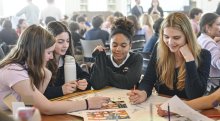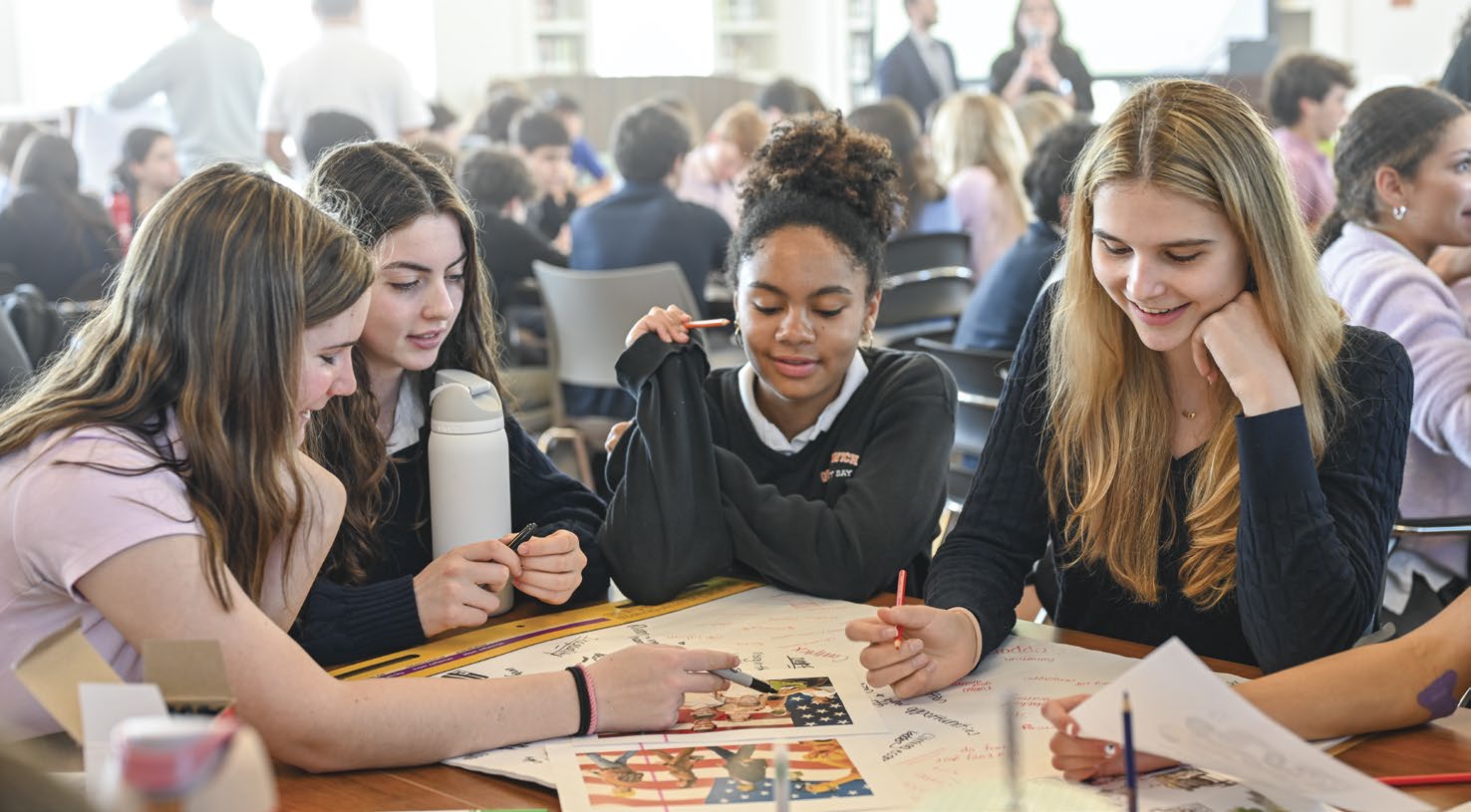
By Dr. Andrew Ruoss, Upper School Academic Dean
Perhaps more than recent generations before them, our current Upper Schoolers have lived through public narratives that have described each successive year of their adolescence as “unprecedented,” “complicated,” and “complex.” Leaning into this experience, a talented, interdisciplinary team of 10th grade American Studies faculty has embraced the challenge of working with their students to decode the dynamics of contemporary American society. The capstone of this exploration is the American Dream Project, through which students analyze the core societal systems that undergird American life. Cultivating the skills of large-scale, interdisciplinary research, the project also serves as the gateway to the advanced electives, thesis research, and independent studies that await our 10th graders in their Junior year ahead.
NAVIGATING THE AMERICAN EXPERIENCE
Throughout the year-long American Studies program—centered on paired American history and literature courses—10th grade students examine the American experience through three lenses: Freedom, Power, and Mobility. “These three strands run through the stories and history of American lives,” says Annie Ogden, who serves as the 10th grade Curriculum Coordinator and American History Teacher. Over the course of the year, students have worked with faculty to trace these thematic strands throughout American history and literature. Using F. Scott Fitzgerald’s The Great Gatsby as a reflective springboard, students launch into this final project, interrogating the American Dream: the ideal that every American has the opportunity to pursue prosperity through hard work, determination, and ingenuity. The project guides students to apply their learning across their classes as they investigate a contemporary challenge within American society.
As Ogden frames the project, “We’re saying to them: you’ve studied the narratives, ideas, and theories of progress in America—its historical context, its literary representation. Now place yourself in the complexity of the American experience. What do you care about? How might you build a thoughtful solution to a nuanced societal problem?” After a month immersed in interdisciplinary investigation, students finish the year with a public presentation of their data, including proposals for policy solutions. “Through a month of intensive personal work, along with group discussion, debate, and feedback, our 10th graders learn that grappling with complexity requires intellectual resilience and flexible thinking,” Ogden reflects.
COLLABORATIVE TEACHING & RESEARCH
The American Dream project exemplifies the skills of interdisciplinary, mentored research that are at the core of the Upper School experience. The 10th grade teachers structure their class time, space, and challenges to support this approach to learning. Anthony Bowes, Social Sciences Department Lead and 10th Grade American History teacher, describes the rhythm of the American Studies program: “Throughout the year, the English and History classes echo each other: we guide students to work across their classes to explore American literary traditions and the major movements, moments, and debates of American history—navigating The Crucible and Colonial America, reading Frederick Douglass while studying Antebellum South.” With this capstone project, students are in the driver’s seat. They select a societal system through which to analyze a contemporary issue of their choice. Starting with literary analysis of The Great Gatsby, the students simultaneously delve into archival research, tracing the impact of the American education, legal, and housing systems on the characters’ journey within the text. Then, utilizing the resources of the New-York Historical Society and the archives of The New York Times, they map the evolution of communities on Long Island and in the five boroughs of New York, tracing the historical dynamics that Fitzgerald sought to illuminate.
“The project is designed to guide students through the process of unwinding a complex social issue: start with one source as an entry point, then expand the aperture,” says Bowes. Springing from the case study of Gatsby, each student then delves into their own investigation of one of the three systems of education, housing, and law in contemporary American society. Students researching the same system work together to analyze “ripped from the headlines” topics of wealth inequality, housing access, and criminal justice.
The teachers have also created the space and conditions for students to debate and collaborate in this investigation. Scheduled back-to-back, History and English sections combine periods and take over large and flexible break-out spaces in the Upper School. As their teachers structure Harkness discussions, open debates, and workshopping sessions, students learn how to leverage the different research, ideas, and perspectives of their peers to better their own understanding and analysis. “As they gain confidence in their own research, you see the students gradually work together to explore the relationships between issues—learning from each other’s dead ends, successes, and approaches to complexity,” reflects Ogden.
LEVERAGING TRADITION & INNOVATION
An important mission of this project is to show students the value of blending both traditional and innovative sources for understanding the dynamics of American society. According to 10th grade English teacher Lily Fox, “the project honors the American literary canon while also making these crucial and diverse works of literature directly relevant to our 21st-century lives.” Fox continues, “You see how students borrow from the works we’ve read—Emerson, Morrison, Baldwin, Douglass—to inform our lives as Americans now.”
These literary perspectives are further enriched by the quantitative analysis that 10th graders bring to the project from their Math classes. As Algebra II and Trigonometry teacher Kosanna Poon explains, “we’ve worked with the students to build large, current data sets for each of the three societal systems under investigation. We challenge them to run regressions and analyses of median income, CPI, housing cost indices, inflation, and education statistics.” The students then apply this analysis to their solution proposals, and they work together to understand how all of these statistical frameworks interact to demonstrate the health, direction, and accessibility of the American economy. Along the way, Poon explains, “students work through the challenges and approaches encountered by policymakers, economists, and analysts today.”
ENGAGING A WORLD OF CHANGE
As our country heads through an election year, and as American society confronts an array of conflicts, emerging technologies, and new challenges to communication, public health, and governance, it is more important than ever to equip students to engage with the world in which they live. Through challenging programs like the American Dream project, our faculty bring the mission of GCDS to life: to enable our students “to discover and develop what is finest in themselves” and to apply those skills and talents to better the world around them.”
“I was originally focused on drug policy, and that led me to investigate the juvenile detention system and mental health. I’m digging into research on treatment and the juvenile detention system and the psychological effects of this system. I’m very interested in psychology and concepts like societal order and freedom. I’m able to pull together all the literature and history we’ve studied to focus on this issue.” — Margaux Citrin ’26
“My research focus is standardized testing—the SAT and ACT—and the political and policy arguments around it. In particular, I’m interested in researching debates on the value of diversity: How do standardized assessment programs, like the SAT, work to allow or hinder colleges to construct communities? How do we measure effectiveness? What are the statistics around this issue? All year, I’ve been exploring the theme of opportunity through American literature and history. Standardized testing is positioned as a gateway for opportunity.” — Will Stern ’26
“I’m focusing on the intersection of mental health and housing policy. I’ve been jumping into the data specifically around race/ethnicity, mental illness, and housing accessibility. How do these three issues interact and affect each other? Math has helped me work through statistical analysis, whereas novels like Frederick Douglass and Sula have given me the windows to understand the human experience in these issues. I’m thinking about how Americans shift their understanding of the American Dream based on personal and political identity.” — Mia Secko-Thompson ’26
#gcdsus











.JPG&command_2=resize&height_2=85)





.jpg&command_2=resize&height_2=85)




